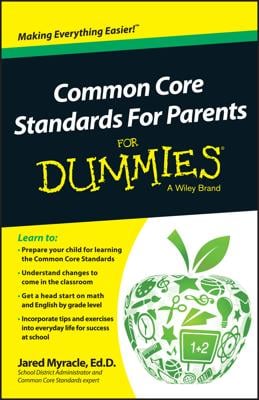The greatest common factor (GCF) of a set of numbers is the largest number that’s a factor of every number in that set. Finding the GCF is helpful when you want to reduce a fraction to its lowest terms.
You can find the GCF in two ways. The first option is to list all the factor pairs of the numbers and choose the largest factor that appears in both (or all) the lists.
The other method uses prime factors, which I discuss in the preceding section. Here’s how to find the GCF:
Decompose the numbers into their prime factors.
Underline the factors that all the original numbers have in common.
Multiply the underlined numbers to get the GCF.
Sample questions
Find the greatest common factor of 12 and 20.
4. Write down all the factor pairs of 12 and 20:
Factor pairs of 12: 1 x 12, 2 x 6, 3 x 4
Factor pairs of 20: 1 x 20, 2 x 10, 4 x 5
The number 4 is the greatest number that appears in both lists of factor pairs, so it’s the GCF.
Find the greatest common factor of 24, 36, and 42.
6. Decompose all three numbers down to their prime factors:
24 = 2 x 2 x 2 x 3
36 = 2 x 2 x 3 x 3
42 = 2 x 3 x 7
Underline all factors that are common to all three numbers:
24 = 2 x 2 x 2 x 3
36 = 2 x 2 x 3 x 3
42 = 2 x 3 x 7
Multiply those underlined numbers to get your answer:
2 x 3 = 6
Practice questions
Find the greatest common factor of 10 and 22.
What’s the GCF of 8 and 32?
Find the GCF of 30 and 45.
Figure out the GCF of 27 and 72.
Find the GCF of 15, 20, and 35.
Figure out the GCF of 44, 56, and 72.
Following are the answers to the practice questions:
The GCF of 10 and 22 is 2.
Write down all the factor pairs of 10 and 22:
10: 1 x 10, 2 x 5
22: 1 x 22, 2 x 11
The number 2 is the greatest number that appears on both lists.
The GCF of 8 and 32 is 8.
Write down all the factor pairs of 8 and 32:
8: 1 x 8, 2 x 4
32: 1 x 32, 2 x 16, 4 x 8
The greatest number that appears on both lists is 8.
The GCF of 30 and 45 is 15.
Write down all the factor pairs of 30 and 45:
30: 1 x 30, 2 x 15, 3 x 10, 5 x 6
45: 1 x 45, 3 x 15, 5 x 9
The greatest number that appears on both lists is 15.
The GCF of 27 and 72 is 9.
Decompose 27 and 72 into their prime factors and underline every factor that’s common to both:
27 = 3 x 3 x 3
72 = 2 x 2 x 2 x 3 x 3
Multiply those underlined numbers to get your answer: 3 x 3 = 9.
The GCF of 15, 20, and 35 is 5.
Decompose the three numbers into their prime factors and underline every factor that’s common to all three:
15 = 3 x 5
20 = 2 x 2 x 5
35 = 5 x 7
The only factor common to all three numbers is 5.
The GCF of 44, 56, and 72 is 4.
Decompose all three numbers to their prime factors and underline each factor that’s common to all three:
44 = 2 x 2 x 11
56 = 2 x 2 x 2 x 7
72 = 2 x 2 x 2 x 3 x 3
Multiply those underlined numbers to get your answer: 2 x 2 = 4.

